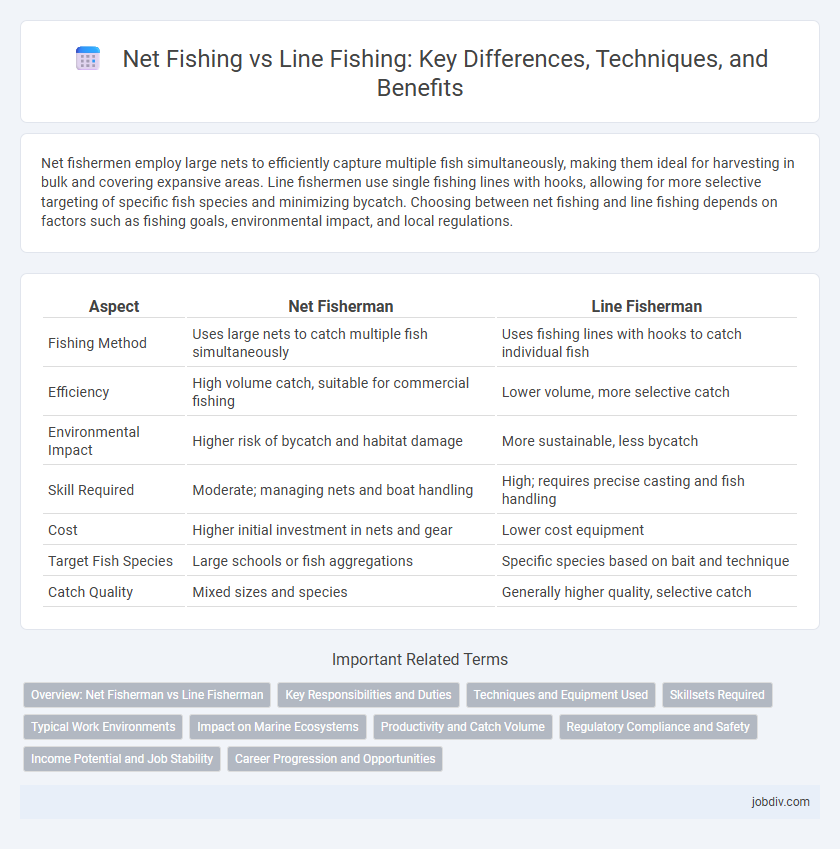Net fishermen employ large nets to efficiently capture multiple fish simultaneously, making them ideal for harvesting in bulk and covering expansive areas. Line fishermen use single fishing lines with hooks, allowing for more selective targeting of specific fish species and minimizing bycatch. Choosing between net fishing and line fishing depends on factors such as fishing goals, environmental impact, and local regulations.
Table of Comparison
| Aspect | Net Fisherman | Line Fisherman |
|---|---|---|
| Fishing Method | Uses large nets to catch multiple fish simultaneously | Uses fishing lines with hooks to catch individual fish |
| Efficiency | High volume catch, suitable for commercial fishing | Lower volume, more selective catch |
| Environmental Impact | Higher risk of bycatch and habitat damage | More sustainable, less bycatch |
| Skill Required | Moderate; managing nets and boat handling | High; requires precise casting and fish handling |
| Cost | Higher initial investment in nets and gear | Lower cost equipment |
| Target Fish Species | Large schools or fish aggregations | Specific species based on bait and technique |
| Catch Quality | Mixed sizes and species | Generally higher quality, selective catch |
Overview: Net Fisherman vs Line Fisherman
Net fishermen use large mesh nets to capture multiple fish simultaneously, enabling high-volume catches critical for commercial fishing operations. Line fishermen rely on fishing lines with hooks, offering selective targeting of species and reducing bycatch, favored in sport fishing and sustainable practices. Both methods contrast in scale, environmental impact, and catch precision, shaping their roles across different fishing industries.
Key Responsibilities and Duties
Net fishermen operate and manage various types of fishing nets, ensuring proper deployment, maintenance, and retrieval to maximize fish catch while minimizing environmental impact. Line fishermen focus on using fishing lines, including handlines and longlines, to target specific species, requiring skill in baiting, hooking, and careful handling to preserve fish quality. Both roles demand knowledge of fishing regulations, safety protocols, and sustainable practices to support marine ecosystem health.
Techniques and Equipment Used
Net fishermen employ large-scale, passive or active netting techniques such as trawling and gillnetting, utilizing equipment like seine nets, drift nets, and trawl nets to capture schools of fish efficiently. Line fishermen rely on manual or mechanized lines, using methods like hand-lining, long-lining, or trolling with hooks baited individually, often requiring precise knowledge of fish behavior and advanced rod, reel, and line technology. The choice between net and line fishing significantly impacts catch selectivity, environmental sustainability, and gear maintenance practices.
Skillsets Required
Net fishermen require expertise in deploying and maneuvering complex fishing nets to capture large quantities of fish efficiently, demanding strong physical endurance and precise coordination. Line fishermen depend on keen knowledge of fish behavior, bait selection, and casting techniques to increase catch accuracy, requiring patience and tactical skill. Both methods necessitate understanding marine environments, but net fishing prioritizes teamwork and equipment handling, while line fishing emphasizes individual precision and adaptability.
Typical Work Environments
Net fishermen commonly operate in coastal and shallow waters, often working from larger vessels designed to deploy and retrieve expansive fishing nets. Line fishermen typically work in deeper waters or along reefs, using smaller boats to manage longlines or handlines for targeting specific fish species. Both professions require specialized gear tailored to their distinct fishing methods and environmental conditions.
Impact on Marine Ecosystems
Net fishermen often cause greater disruption to marine ecosystems due to their broad, indiscriminate capture of fish and bycatch, leading to habitat destruction and depletion of non-target species. Line fishermen typically exert less ecological pressure by targeting specific species and using selective gear, which helps maintain population balance and limits damage to the seafloor. Sustainable fishing practices favor line fishing methods for preserving biodiversity and ensuring long-term marine ecosystem health.
Productivity and Catch Volume
Net fishermen typically achieve higher catch volumes due to the ability to capture large schools of fish simultaneously, resulting in greater productivity per trip. Line fishermen, while often yielding lower overall catch volumes, benefit from more selective fishing practices that reduce bycatch and target specific species, potentially enhancing long-term sustainability. The productivity gap is influenced by factors such as fishing gear efficiency, fish population density, and environmental regulations impacting both methods.
Regulatory Compliance and Safety
Net fishermen must adhere to strict regulations regarding net mesh size, fishing zones, and catch limits to prevent overfishing and protect marine ecosystems, ensuring sustainable practices. Line fishermen face specific rules on bait types, hook sizes, and seasonal restrictions to minimize bycatch and preserve fish populations. Both techniques require compliance with safety protocols, including proper vessel maintenance and use of personal protective equipment, to reduce accidents and promote safe working conditions on the water.
Income Potential and Job Stability
Net fishermen generally experience higher income potential due to the larger volume of fish harvested per trip, enabling consistent sales to commercial markets. Line fishermen often face fluctuating earnings tied closely to weather conditions and fish migration patterns, resulting in less predictable income streams. Job stability tends to be greater for net fishermen who operate within established commercial fisheries, while line fishermen frequently depend on seasonal shifts and smaller-scale operations.
Career Progression and Opportunities
Net fishermen often have access to larger-scale commercial operations offering faster career advancement through roles such as crew leader or vessel captain, supported by collective training programs within fishing companies. Line fishermen typically operate on smaller vessels or independently, allowing for more flexible career paths but requiring greater individual skill development and offering opportunities in niche markets like sport fishing or artisanal trade. Both careers present unique growth prospects, with net fishing favoring structured hierarchy and line fishing enabling entrepreneurship and specialization.
Net Fisherman vs Line Fisherman Infographic

 jobdiv.com
jobdiv.com